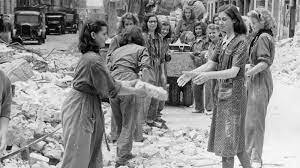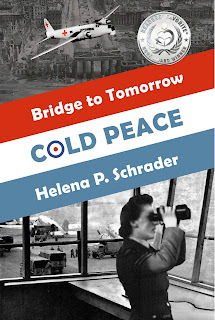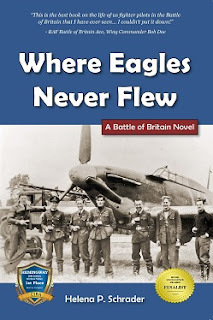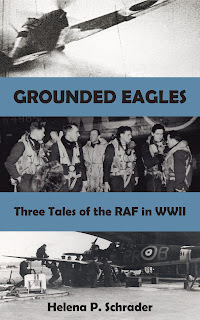Dissecting "Cold Peace" Part V - "The Worm's View" Plot Line
The second major plot line in "Cold Peace" is the "Worm's View." The point of this plotline is to take the reader out of the clouds where history is spread out for inspection and decisions are being made and try to show what it was like living through the events described.

Most of us go through our lives as the objects of destiny. We are impacted by historical events without having any opportunity to alter them. We might have voted for the politicians that make war or peace -- but it is just as likely that we did not. We certainly have no influence on the actions of foreign powers, yet they have the power to transform our lives.
The strands of this plot line are the stories of ordinary people struggling to survive in post-war Europe. They provide insight into what things looked like "on the ground" with the benefit of insight into the corridors of power. Their concerns are, for the most part, our concerns: finding a job, keeping food on the table, protecting and raising our children, finding love and a partner for life.
In the aftermath of WWII, most of these simple things were challenging in Europe. The U.S. Undersecretary ofState, Dean Acheson, summarized the situation as follows: “Life in Europe as an organised industrialcommunity had come well-nigh to a standstill and, with it, so had productionand distribution of goods of every sort.” Furthermore, agricultural productionwas “lower than at any time since the turn of the century.”
On top of this, the winter of ’46-’47 proved to be the most severewinter in a century. Temperatures dropped far below freezing and stayed therefor weeks on end. In Berlin the water supply froze and that meant the sewagesystem collapsed. So did the railway, preventing the importation of coal.Unable to provide coal for private consumption, public places from pubs andcinemas to air raid shelters were turned into public warming halls. Schoolswere put on short-weeks and factories were closed. Over 1,000 Berlinersliterally froze to death, 60 on one night alone. One Berliner who lived throughthe winter measured the temperature in her kitchen at -6 degrees centigrade anddescribed how her bread was frozen solid. She went on to say:
Most of the families which sold their porcelain,carpets, and furniture to get money to buy fat and meat on the blackmarket…have nothing more to sell and are no longer able to buy black marketfood. People have no coal to heat rooms…Old people are dying like flies…Thereis no water in the houses because all is frozen.
In Britain the situation was only marginally better. The frigid winter,even more unusual in the UK than in Berlin, exhausted coal reserves, leading topower shortages. In December, England’s largest auto plant was forced to shutdown. Then the Thames froze all the way from Windsor to the sea, closing Londonto coal barges and preventing the supply of coal to power stations. Electricityto households was reduced to six hours per day, three in the morning and threein the afternoon. By February, the crisis was so acute and widespread that theGovernment ordered all non-essential factories to close for three solid weeks.Unemployment shot up to 2.3 million. Welfare payments for these unemployeddrained the already depleted treasury. Meanwhile the Government had also beenforced to cut food rations to below wartime levels.
The cold receded, but the mood of despondency remained -- in both Britain and Berlin. In Germany, however, doctors also reportedan increase in TB, pneumonia and other illnesses. By now most urban dwellers inGermany (and that was the majority) had not seen milk, sugar, fat or vegetablessince the end of the war. Chronic under-nourishment had become a problem,causing a drop in industrial production per worker by 20%. People, particularlythe elderly, were dying of hunger still. A social worker summed up thesituation by saying: “The energies of the people are spent in pursuit of a loafof bread and a pair of shoes. Hope is alien.” Rationswere now set at 1,275 calories per day in the U.S. zone (still less than halfwhat Americans then considered normal) and at 1,040 calories in the Britishzone, which was more industrial and had less agriculture than the U.S. zone. Inthe French Zone the rations were set at just 925 calories – causing the Germansto refer to it as the “FZ” in a play on the German term for ConcentrationCamps, “KZ.” It was now “a vicious circle in which the Germans starved becausethey could not produce enough, and could not produce enough because they werestarving.”
The economics wasn't the only shadow darkening the horizon of Europeans at the start of 1948. Another kind of threat was also growing. It was the threat of Soviet tanks. The Soviet Union had already expanded into the Baltic States, parts of Finland, it had swallowed large parts of Poland and taken control of the remainder as well. It has staged Communist "coups" that gave the Soviet Union effective control of Hungary, Bulgaria, Romania, and Czechoslovakia. The Soviet Union clearly had its eye on Germany -- starting with Berlin. Their tactics were various forms of intimidation to make the population docile and ready to accept Soviet rule.
For example, as far back as early 1946 there had been isolated incidents ofSoviet police abducting persons from the Western Sectors; three municipaljudges who had refused to render judgements desired by the Soviets had“disappeared” from their homes, never to be seen again. However, by early 1948, various observers reported seeing an increased use of abduction. An Americanintelligence officer based in Berlin reported that Russians, disguised asGerman police, were arresting German officials living in the U.S. and Britishsectors of Berlin. Police officers who were not sufficiently loyal to the SEDand Soviet Union were also targeted for such actions and disappeared.
But itwas not only city officials who feared abduction, German scientists werelikewise kidnapped from their homes and sent to work in the Soviet Union,particularly on the atomic bomb project, simply because they had skills theSoviet Union needed. Indeed, even ordinary German workmen and skilled female labourers couldfind themselves deported on two hours notice. Although different in character, the Soviets did not shy away from temporarily kidnapping members of the Western Allied occupation forces. General Clay reported that 93 Americanservicemen were detained in the first half of 1948 and claimed few of the arrests hadany justification. Nevertheless, in many instances “the Americans were held forhours under humiliating conditions….”
In order to facilitate a take over, the Soviets needed the Western Allies out of their way and that meant convincing them that remaining in Berlin was too burdensome. The Soviet's chosen tactic to achieve this objective was the harassment of inter-zonal traffic. This took many forms. One simple tactic of the Soviets was to send Russiansoldiers dressed in civilian clothes to systematically rob passengers arriving atthe train stations. On other occasions, Soviet soldiers openly held up bussesof the public transport network at gunpoint and took what they liked withoutbothering about disguising themselves.
More subtle but equally effective wasthe Soviet tactic of changing without notice the bureaucratic requirements forpossession of a license to operate a lorry. Everyone was required to possess alicense from the SMAD, but the form, shape or colour of this license couldchange without warning from one day to the next. When this happened, all lorrytraffic came to a virtual halt while drivers and firms scrambled to get the newdocuments. After paying the fees and standing in lines and collecting thesignatures and stamps for the new document, the owners of such documents had nocertainly that the rules would not change again the next day – and naturallysuch documents were completely unobtainable if one had incurred the displeasureof the SMAD in one way or another.
The Soviets also introduced new licenses formoving from the Western Sector to the Western Zone, and the costs anddifficulties of obtaining the licenses brought such movements to a virtual standstill.The harassment of German passengers traveling between Berlin and the WesternZones also escalated, so that Germans had to dread not only intrusive searches(which often ended in official and unofficial confiscations) but also feared arrestfor alleged infractions of rules they had never heard of.
The "Worm's Eye" Plotline attempts to capture for the reader the feelings of people -- like you and me -- facing this catastrophic economic situation and the growing manifestations of Soviet determination to make Berlin part of Stalin's empire.
-------
Richard Cutler, Counter Spy,p. 142
Collier, Bridge Across the Sky, p.10.
Robert Jackson, The Berlin Airlift, P.24.
Cold Peace is Book I of the Bridge to Tomorrow Series.
Three years after WWII, Europe struggles with rationing, widespread unemployment and a growing Soviet threat. Hitler's former capital lies ruined under the joint control of wartime allies bitterly at odds. With the currency worthless, the population lives on hand-outs or turns to crime and prostitution. Deep inside the Soviet Zone of occupation, Berlin appears to be an ideal target for a communist take-over, putting the defenders of democracy on a collision course with Stalin's merciless aggression.
A Battle of Britain ace, a female air traffic controller, a concentration camp survivor and an ex-ATA woman pilot are just some of those trying to find their place in the post-war world. An air ambulance service offers a shimmer of hope, but when a Soviet fighter brings down a British passenger liner, Berlin becomes a flashpoint. The world stands poised on the brink of World War Three.

Find out more at: https://www.helenapschrader.com/bridg...
View a video teaser at: https://www.youtube.com/watch?v=JTuE7...
Previous releases include:
" MORAL FIBRE," which WON THE HEMINGWAY AWARD 2022 FOR 20TH CENTURY WARTIME FICTION and a MAINCREST MEDIA AWARD FOR MILITARY FICTION as well as being A FINALIST FOR THE BOOK EXCELLENCE AWARD 2023 IN THE CATEGORY HISTORICAL FICTION.
Riding the icy, moonlit sky,they took the war to Hitler.
Their chances of survival were less than fifty percent.
Their average age was 21.
This is the story of just one bomber pilot, his crew and the woman he loved.
It is intended as a tribute to them all.
or Barnes and Noble.
 "This is the best book on the life of us fighter pilots in the Battle of Britain that I have ever seen.... I couldn't put it down."-- RAF Battle of Britain ace, Wing Commander Bob Doe.
"This is the best book on the life of us fighter pilots in the Battle of Britain that I have ever seen.... I couldn't put it down."-- RAF Battle of Britain ace, Wing Commander Bob Doe.
Winner of a Hemingway Award for 20th Century Wartime Fiction, a Maincrest Media Award for Military Fiction and Silver in the Global Book Awards.
Find out more at: https://crossseaspress.com/where-eagles-never-flew
For more information about all my books visit: https://www.helenapschrader.com
 Disfiguring injuries, class prejudice and PTSD are the focus of three tales set in WWII by award-winning novelist Helena P. Schrader. Find out more at: https://crossseaspress.com/grounded-eagles
Disfiguring injuries, class prejudice and PTSD are the focus of three tales set in WWII by award-winning novelist Helena P. Schrader. Find out more at: https://crossseaspress.com/grounded-eagles




